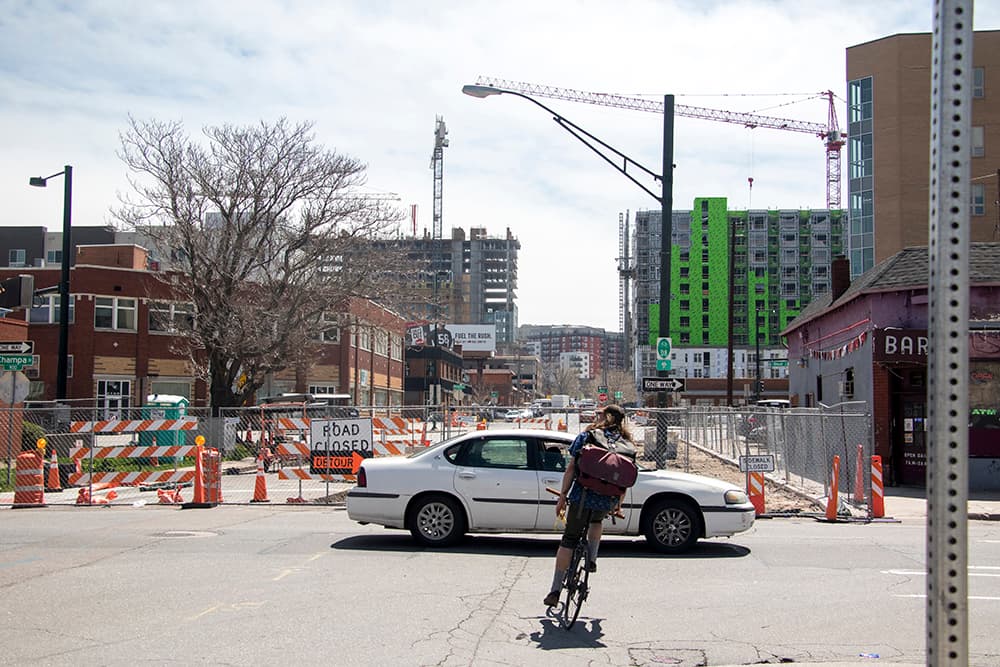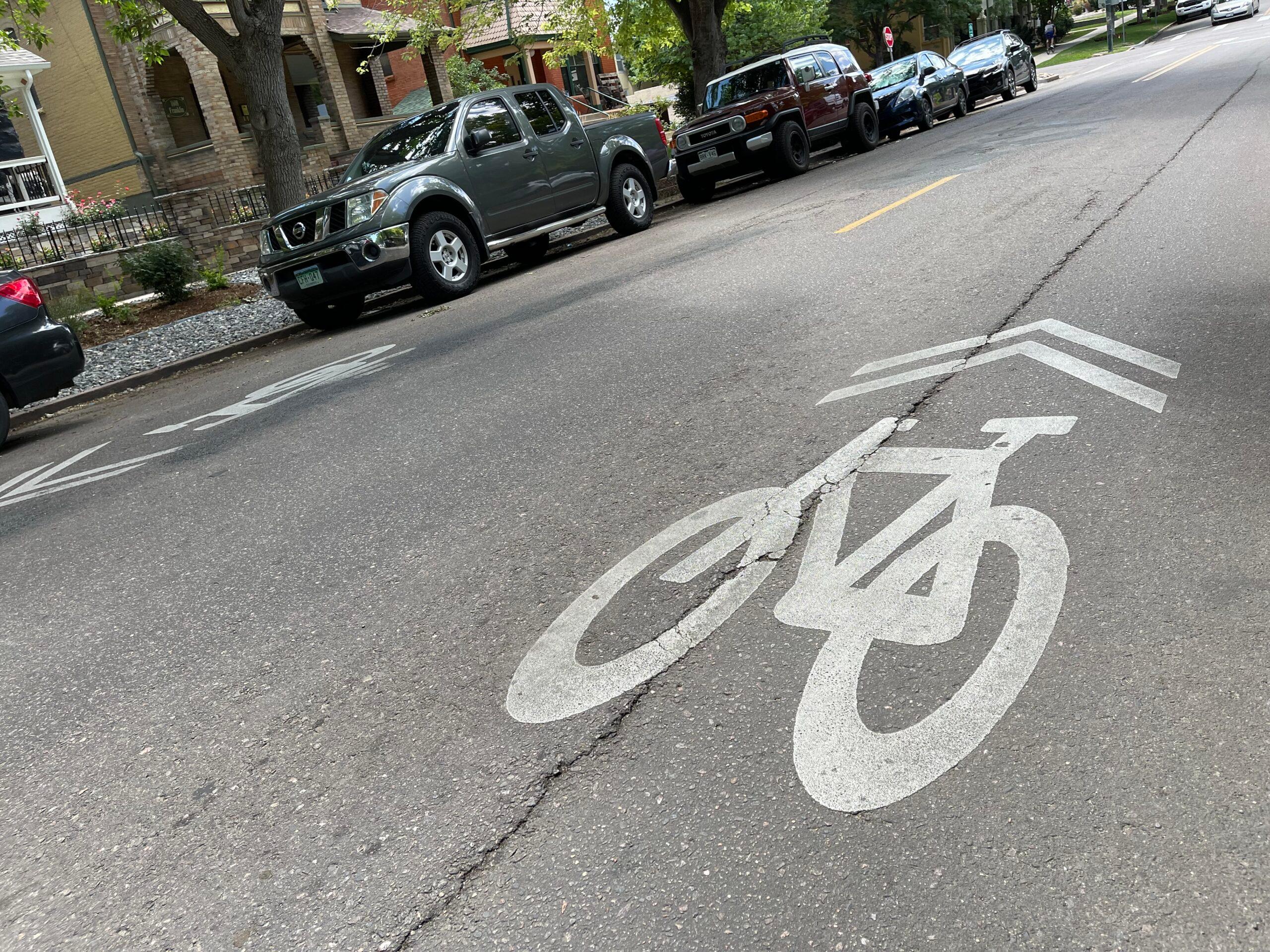Sometimes Denver bike commuters follow the bike icons and arrows on roads like 23rd Avenue or Franklin Street. Generally, not for long.
Riding in the middle-ish of their lane on the so-called "sharrows," as they're supposed to, cyclists can pedal through a few close calls and rude remarks.
The trouble is: Drivers don't see sharrows, and even if they do, they likely don't understand what sharrows mean. So what are they, anyway?
Sharrows are those icons painted on the streets with a rider-less bike underneath two arrows. Another term for them: lane-share markers.
In Denver, they're painted by the Department of Transportation and Infrastructure on streets that have no bike lanes but are supposedly welcoming to both bikes and cars.
In theory, when followed, sharrows encourage a biker to take the entire lane of traffic and caution drivers to chill out, slow down, and get in line. Sharrows can also keep riders out of the door lane -- where people leap from their cars, swing open their doors and fling bikers toward doom.

Sadly, the implementation isn't as tidy as the idea.
Some sharrows are painted too near the door lane, luring cyclists, eager to obey city signage, into harm's way. Other lane markings are too close to the dividing line between cars going in different directions.
Drivers sometimes don't see bikers -- so why would they see bike logos? And for many drivers, who took their exams before sharrows started striping the streets in the '90s, they are as meaningful as a wad of tar-dyed gum on the road.
Many Denver bike commuters will tell you: Sharrows don't make them feel safe -- and some research backs that. According to a 2016 University of Colorado, Denver study of bike infrastructure conducted over ten years and on 2,000 blocks in Chicago, sharrows might actually be more dangerous than no infrastructure at all.
Just like watery Coors, blistering Crocs, and the pesky boot on your car wheel that forces you to bike, the sharrow is a Colorado invention.
Sharrows have made their way around the globe.
Thrifty urban planners, disinterested in building significant bike infrastructure, have embraced them.
Sharrows give city officials a cheap way to say they're doing something for cyclists' safety -- even if it's undermining it.

We tracked down the man credited with inventing the sharrow, happily retired Denver bicycle traffic engineer James Mackay, and interrupted his morning tooth-brushing to find out how and why the sharrow came to be.
When Denver hired Mackay in the early '90s, he said, the city made their priority clear: They didn't want him to do anything -- certainly, nothing involving change or money.
The city was still recovering from the oil and gas bust. Bigwigs were fighting for mega projects like Coors Field. Bike lanes? No dice.
"It's that balky recalcitrance: 'Oh, we've done enough. Let's not do anything else. We've got other priorities,'" Mackay said. "That's been vexing my entire career. I'm joyously retired -- but that was the mentality I was dealing with."
So Mackay started refining an idea he had dreamed up when he was working as an engineer in North Carolina: a cheap-to-paint marking that could go on the pavement to indicate to drivers that the road should be shared. He called it "the shared-lane marking."
Mackay's original version had an outline of an arrow with a bicyclist inside of it.
"So you had the two wheels, the bike, the bicyclist figure astride the wheel, and that was inside a hollow arrow, but commonly referred to as 'man jumping barrels at home,'" he said.
San Francisco commissioned a study between Mackay's version and another from France: chevron signs -- basically, arrows -- above the bike symbol. It turned out, that symbol worked better.
"You might think my feelings were hurt," Mackay said. "They weren't. They proved which one works better. What I came up with was just a guess on my part. Now we had actual data paid for by San Francisco -- not by the bike community, not by the bike industry, not by the City of Denver.
"That allowed us to take it to National Committee and go through their vexing convoluted process to make it an official standard," he said.
The sharrow was finally added to the Manual on Uniform Traffic Control Devices in 2009, the product of countless grueling meetings and studies. That could have been a triumph in Mackay's career -- but was mostly a nothing burger to Denver officials.
"All that happened," he said. "Nobody at the City congratulated me."

Mackay leaves the future of bike infrastructure up to today's advocates and engineers while enjoying living his bliss in retirement. But he does defend some of the merits of sharrows.
Bike lanes, which require painting stripes block after block, require more maintenance, he said. Shared bike lanes use less material.
When bike lanes fade under car traffic, they can be expensive to repaint. With sharrows, you just have to replace individual ones -- not blocks' worth.
"Another advantage of the shared lane marking is that cars can use the entire lane when bikers aren't present," he said. "And that helps with the displaced air from a car, kind of a sweeping action to blow the sand, glass, gravel, jagged shards of broken glass, etcetera, into the curb line. When you put in a bike lane, you don't get the displaced air from the car traffic, and oftentimes you will see the sand, glass, gravel, etcetera accumulate in the bike lane."
Sharrows took off in cities, from Los Angeles to San Francisco to Chicago, Burlington, Vermont, and Louisville, Kentucky.
City planners loved them because they were cheaper to install than painted or protected bike lanes.
"'It's something we can do for bikes, something that doesn't require the expenditure and maintenance of bike lanes' -- that always has an appeal," he said, jabbing officials who ask: "Does this mean we don't have to do as much?"
Transportation departments' maintenance budgets rarely increase, which makes installing infrastructure that requires regular upkeep less enticing.
"People at these transportation areas are always very averse to any new idea because they can't maintain what they already got," Mackay said.
Given funding and political will, Mackay knows Denver could have done more, such as cities like Copenhagen and Utrecht, to actively discourage driving and encourage biking.
But politicians didn't have that vision.

If the city didn't have Mackay's back for expanding Denver bike infrastructure, surely the cycling community would... right?
Mackay, who served on the board of the Denver Bicycle Touring Club, asked for help. That proved futile.
"All those guys care about is riding high-priced bicycles on a Saturday morning," he said. "They drive to the ride-start location, and they take their bike off the roof rack, and only then do they become a cyclist. They'll ride 30 to 50 miles on a Saturday. I was trying to get them to ride three to five miles a week for transportation on a weekday. Zero Interest. Active disinterest."
When the city was working on its Bicycle Master Plan, Mackay brought copies to the board of the club and told them he wanted their support in implementing it. They refused, arguing they were not set up to do that.
Mackay was infuriated. The group's bylaws explicitly stated the organization should work with transportation officials to improve conditions for all cyclists.
"The bike clubs don't think in terms of weekday bicycling and making things better for people who do not have the fancy bikes," he said. "I'm talking about the people riding their bikes out of economic necessity: the Girl Scout who wants to ride her bike to the library, the liquor store clerk that needs a bike so he can get to work. Those sorts of bicyclists who were riding the Walmart-type bikes -- not the $1000, $2,000 bike-shop bikes -- just don't register with the bike clubs."
He couldn't even get the clubs to sponsor safety workshops for kids.
"I wish people well who want to improve things for bicyclists," he said. "But the bike community doesn't care and specifically does not support people who try and make things better for them."
Denver bike commuters and their allies have gained significant political momentum in recent years.
The city continues to build bike lanes -- some connected, fewer protected. Community support led to a new protected bike lane on South Marion Parkway after a cyclist was killed there. The long-promised Broadway bike lane's completion is perhaps somewhere on the horizon.
Advocates have pushed lawmakers to pass cyclist-friendly laws like the Idaho Stop. Denver is funding e-bike rebates, and cyclists are actively pushing for an end to sharrows.
But Mackay believes there are many more in the racing community and casual weekend warriors who could show up to City Council meetings, call 311 and write DOTI.
Correction: The 2016 study on sharrows was conducted by the University of Colorado, Denver, not University of Denver.













